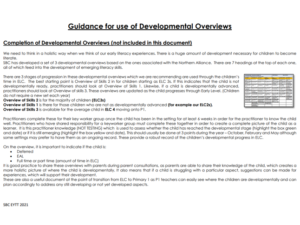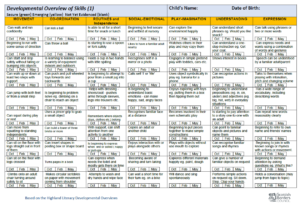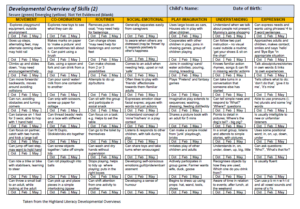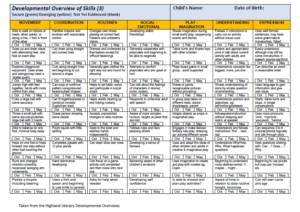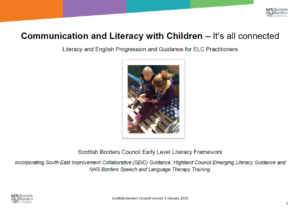Emerging Literacy & English
Oral Language & Phonological Awareness
What is it?
“Phonological Awareness is the awareness of all of the sounds of language. It’s the ability to hear and distinguish sounds. This includes: recognising sounds, adding sounds, taking apart sounds and moving sounds around. Phonological awareness helps children become prepared to learn how letters and sounds go together in words. This makes it easier for them to read and write. Phonological awareness has been found to be a strong predictor of literacy development. Weak skills in phonological awareness are a primary cause for reading difficulties.”
(Phonological Awareness, Hertfordshire SEND Service, 2021)
“Oral language (OL), sometimes called spoken language, includes speaking and listening—the ways that humans communicate with one another. OL skills provide the foundation for word reading and comprehension. They are at the heart of listening and reading comprehension, serving as a predictor for both.”
(Oral Language – What is it?, Literacy How, 2020)
Key messages:
- Practitioners must complete SBC Early Years Emerging Literacy training packages 1-4, and then use these sessions to support whole setting professional dialogue to evaluate current provision, develop practice and improve outcomes for all children.
- Practitioners use Scottish Borders Council Developmental Overviews and Literacy Trackers to identify to plan for the developmental stage of children’s oral language and phonological awareness (see tabs at the bottom of this page).
- Knowledgeable practitioners share, value, understand and support the developmental progression of children’s understanding of, ability to use spoken language, and phonological awareness. This is inclusive of:
-
- Observing
- Interacting
- Planning
- Provision of opportunities
- Practitioners use the Highland Emerging Literacy website to support their knowledge and understanding of developing oral language.
- As children move into Primary 1, teachers explore the Phonological Awareness Developmental Continuum before using the Phonological Awareness Informal Assessment screening tool to assess the children’s development. Once this is established, they can provide opportunities to support these skills before introducing formal phonics teaching.
Ways we can do this:
Observing: Practitioners demonstrate their knowledge of language development through the content of observations, developmental overviews and trackers that reflect the individual child’s learning or skill development, how the practitioner has supported this, and possible lines of development.
Interacting: Practitioners encourage extended use of language and vocabulary through the Keys to Communication and Wee Talk Borders.
To support this, practitioners should provide repeated exposure to experiences where children can encounter vocabulary multiple times to embed the learning. Then, as the children engage, practitioners repeat and add to the child’s vocabulary as they interact, e.g. if a child had been repeating a single word to describe or label an object or toy:
CHILD – “Car!”
ADULT – “The red car!” or “A big fast car!”
When doing this, add one or two words to build up vocabulary slowly through repetition.
Practitioner interactions are responsive to the child’s stage of skills development. They support children to talk things through and allow adequate thinking and response time Wait, Watch, Wonder and sensitive interactions.
Practitioners should support this by helping children to feel comfortable communicating in a positive emotional environment by:
- Forming secure, nurturing attachments with the children while considering their developmental stage and individual needs, interests, and dispositions.
- Creating a range of alternative spaces for children to share reflective conversations.
When resolving conflict, use nurturing and restorative approaches, modelling language and verbalising what happened, possible emotions and potential solutions.
Create open spaces and cosy nooks. Some spaces are for hustle, bustle, and excitement, and others are for calm, relaxation, and reflection.
Inclusive communication approaches are understood and used.
Use gestures, signs, and/or visuals, beneficial for all children’s language development. Teaching all children Signalong gestures is useful.
Use a visual day schedule (Early Learning and Childcare stage), a visual timetable (Primary 1 stage) with the whole class, or ‘now and next’ boards where needed.
Support use of home language where children have English as an additional language.
Value, understand, notice and respond in a nurturing way to all behaviour as a method of communication.
Planning: Practitioners plan and provide developmentally appropriate, progressive opportunities for oral (spoken) and aural (listened to) language and phonological awareness, both indoors and out.
SBC Developmental Overviews and Literacy Trackers are kept current. These are used to identify any ‘shared gaps in learning’, which are targeted through the intentional promotion and possible individual lines of development that use the children’s interests and dispositions.
Provision of opportunities: To promote opportunities for talking and listening, practitioners use:
- ‘Provocations’ or ‘invitations’ in continuous provision to stimulate interest, curiosity and wonder.
- Authentic, natural, open-ended, exciting and unusual objects support descriptive language development.
Practitioners should model new vocabulary and more complex words as they interact with these resources alongside the child.
Practitioners should provide frequent opportunities for responsive and intentionally promoted rhymes, songs, stories and games with repetitive rhythm and vocabulary.
Use of planned Rhyme of the Week revisiting the rhyme each day with a different focus, e.g. rhythm, word boundaries and syllables.
Use planned Story of the Week, focusing on story elements such as character, setting, and plot using descriptive and concept words. This is an excellent opportunity to select a meaningful Word of the Week. Opportunities to engage with and explore the word chosen are facilitated in spaces and experiences, modelled and explained as adults interact with it alongside the child.
Rhyme and Story of the Week baskets that remain available indoors and out should be well resourced and easily accessible.
Carefully plan any group times such as snack, story and rhyme time around children’s play experience. Consider a ‘rolling snack’ and have group times near a natural break. Be careful to ensure these times remain unrushed to allow time to engage in social learning discussions.
View and use snack and lunchtimes as learning opportunities. Engage the children in social ‘chat’, taking the opportunity to model listening, attending and turn-taking skills in a relaxed way alongside new words and vocabulary.
Practitioners provide a range of listening experiences, e.g. following instructions, visitors, stories online, songs or stories in a language other than English.
Practitioners provide a range of experiences to develop phonological awareness, for example:
- Listening walks
- Animal sound lotto
- Clapping and repeating simple rhythms
- Hidden musical instruments where children listen and identify the instrument being played
- Retelling stories such as ‘We’re going on a Bear Hunt’ and making sound effects.
Use virtual resources such as Scottish Borders Council, Youth Music Initiative support materials Developing Literacy through Music – Making Music and the YMI Early Years YouTube Channel.
Parental Engagement: Develop a parental understanding of oral language and phonological awareness through social media, trackers, and developmental overviews to encourage them to model and support these at home.
Learn more about Emerging Literacy & English
Learn more about (Pre-hand) Writing
Learn more about Concepts of Print/Pre-Reading & Emergent Writing
Linked Areas of Practice
Concepts of Print/Pre-Reading & Emergent Writing
Emerging Literacy & English
(Pre-hand) Writing
Tools
Reflecting on Practice
SBC Guidance to support
National Guidance to support
Further Reading to support
Training to support
SBC Early Years BITESIZE training video Oral Language and Phonological Awareness:
Follow link for acronyms used in presentations
No supporting materials
To see all the SBC Early Years training videos visit:
- Guidance for use of Developmental Overviews
- SBC Developmental Overview 1
- SBC Developmental Overview 2
- SBC Developmental Overview 3
- SBC Literacy Progression and Guidance 2025
- SBC Literacy Tracker
- Music to support Phonological Awareness (Youth Music Initiative in SBC)
- Use Voice Memos app for stories & songs

